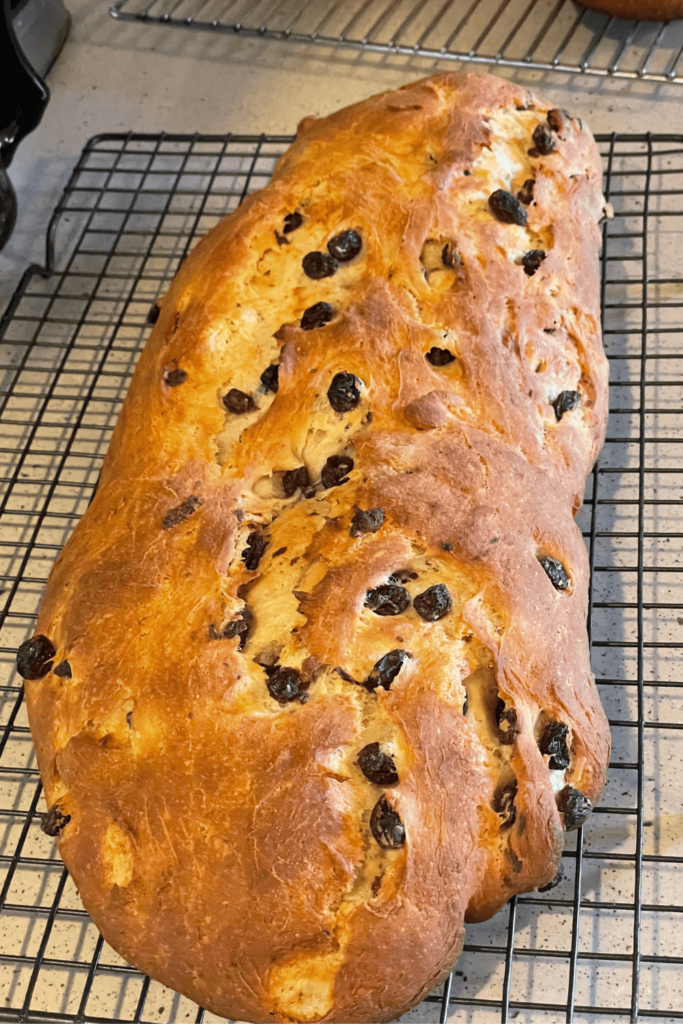Julebrød is Norwegian for “Christmas bread”, although in some parts of the country this same bread is called “julekake”, or Christmas cake. Not sure why, because although this bread is slightly sweet because of added sugar and dried fruits (raisins, and sometimes sukat, or candied citrus peels), it resembles more a loaf of bread than a cake. Whatever you choose to call it, this bread has a long history and is part of an important tradition in Norway.
During Christmas, we often used to eat this sweet, cardamom scented bread for breakfast, which I found was super decadent and a very special occasion – like being naughty early in the morning! Of course, you can eat it anytime of day you want. Today, candied or dried fruit is not used as much as it was in the olden days, only the raisins have stuck. Dried fruit like raisins, dates and prunes were introduced to Norway during the Middle Ages and often traded with dried and salted fish.
I wrote more about the history of julebrød in a previous blog post here, where you can read more about the tradition and background of this delightful bread, so I won’t repeat myself in this updated post.
As a chef, foodie and blogger, I am constantly experimenting with different recipes so that I can experience various methods, ingredients, textures and flavors. This is particularly true for Norwegian cuisine, where there is always a million ways to cook the same dish. Although I have the fondest memories of my mom and grandmother’s recipes, I often get pleasure in finding my own ways to create a traditional dish through my constant curiosity and testing of familiar (and unfamiliar) flavors.
This was the case with julebrød this year. Although the ingredients aren’t dramatically different, the method varies a bit, and made all the difference for me in the lightness and texture of the dough. I simply had to share my updated version with you all!
If you find that you like to experiment too, and are curious to test out different ways to bake the same breads, cookies and cakes, I invite you to try both my recipes as they work beautifully and will show that no eggs or dairy are needed in julebrød either to be a success!
This bread is best straight from the oven, slathered with butter and a cup of hot coffee… but you can easily freeze it as well. One recipe will make three large loaves. This might sound like a lot, but you’d be surprised how easy it is to polish off a loaf in just a couple of days!
Happy baking !
————————————————————————–
NORVEGAN JULEBRØD
about 2 1/2 lbs / 9 cups (1100 grams) all-purpose flour
1 packet (2 1/2 tsp) active dry yeast
2 tsp cardamom
1/2 tsp salt
2/3 cups (150 grams) granulated sugar
2 1/4 cups (6 dl) soy or other non-dairy milk
1 tbsp ground flax seeds mixed with 3 tbsp water
1 stick + 3 tbsp or about 5.25 ounces (150 grams) vegan butter, diced
2 cups (300 grams) raisins
vegan butter for brushing the top of the bread
Place the raisins in a small bowl and cover with warm water until just covered. Soak for about 30 minutes or longer until they plump up.
Place all the ingredients in the bowl of a stand-mixer with the exception of the butter, raisins and the butter to brush the bread, and fit with a dough hook. Knead /combine on low for about 10 minutes until the dough starts to release from the side of the bowl. If the dough is super sticky, you can add a bit more flour. Add in the diced butter gradually and knead for another 10 minutes until the butter is well incorporated into the dough. You can increase the speed of the kneading halfway through. Finally, drain the water from the raisins and carefully add them to the dough. Be careful not to knead too long/forceful, as you don’t wan to mash up the raisins but keep them whole (I like to add in the raisins by kneading them in by hand).
Cover the dough with a clean towel or plastic wrap, place in a warm spot and let rise for at least 1 hour, until the dough has doubled in size.
Prepare two or three baking sheets by lining them with parchment paper or greasing them with a little oil. I found that I could place two loaves on one sheet and the third on its own – but don’t overcrowd the sheet pans. Preheat oven to 400 degrees Fahrenheit (200 degrees Celcius).
Sprinkle a little flour on a clean work surface and divide the dough into three equal parts, and shape them into loaves. Place them onto the prepared baking sheets, cover them with clean towels and let rise again for another 30 minutes.
Brush the top of the loaves generously with melted vegan butter and bake the breads in the bottom rack of the oven for about 25-30 minutes until golden on top. Check after 20 minutes to be sure they don’t over bake. Since I had two trays, I baked mine in two separate sessions. Cool on a rack until cool enough to slice – and enjoy with butter, jam or your favorite topping!












OMG I’m going to make this tomorrow. I just finished making 3 loaves (2nd time ) of your Norwegian bread. Gifts for xmas will be this bread as it is a little less intense but sounds delicious. Thank you for also making it vegan! Our household has been vegan for 14 years and love to see such “kind” recipes. Thanks and cheers to you!
I’m so happy to hear this!! The julebrød is my absolute favorite and would love to hear how it comes out for you… I’m going to make it myself next week! 🙂
If we’re not concerned about baking vegan, can real butter and milk be used in the same amounts/measurements?
Hi Deb,
I imagine they can as I typically convert traditional recipes to vegan versions, although I don’t recommend it on my blog for obvious reasons 🙂
Sunny